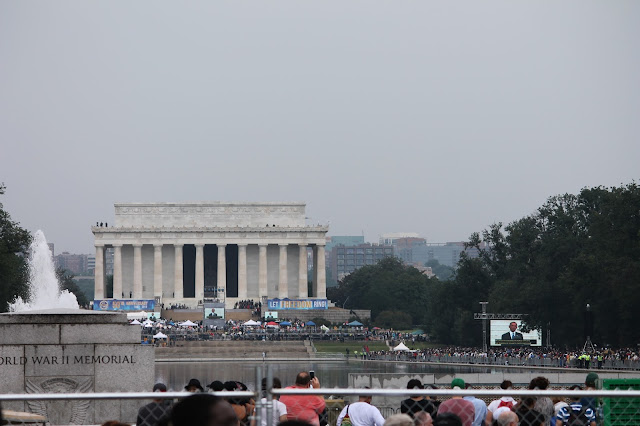The first stop today was the United States Holocaust Memorial Museum. It wasn't busy there today (see below) so I was able to get in without a reservation (I also happened to arrive at the same time as a family with an extra ticket, but we all went in before our appointed time). Yes, the topic is grim, but important. As one comment in the brochure puts it, “It happened. Therefore it can happen again.” At the end of the exhibit they point out it has happened again. One of those places was Rwanda. That brochure also says, “What is your responsibility now that you've seen, now that you know?” Genocide doesn't just happen. There are always warning signs.
There was one big thing I learned. In the 1930s Germany would have been quite content to send all its Jews into exile. As one who has studied music I heard a lot about composers and musicians who fled Germany – Arnold Schoenberg and Wolfgang Korngold are two names of many that readily come to mind. They were able to come to America because of their prominence in the arts. Back to that bit about Germany willing to exile its Jews. One big problem – no other country (including America) would take millions of Jews. They were also too anti-Semitic for that to work. That included British controlled Palestine.
Another thing I learned was that when the camps were opened and Jews were freed, they couldn't return to their home cities. Part of it was that some small towns were completely destroyed. Part of it was because the residents were still quite anti-Semitic and blamed the Jews for their own wartime hardships. Those Jews who appeared were frequently killed.
I'm sure you are thankful I don't have pictures. Camera use was banned.
When I entered I was asked to take an Identification Card. It was a card of a real person who had been caught up in the Holocaust. Mine was for Welek Luksenhurg of Poland, who would have been 16 when the Nazis invaded. The card told me some of his background and I was told I should read certain pages after visiting each floor of the display. We were all warned that there were 500 different ID cards and only 30 of them were about survivors. When Welek was forced into a death-march I figured I knew how his life ended. Thankfully, he was rescued before he died.
The guidebook said to allow two hours. I took more than three. By the end I was quite hungry. The only nearby place to eat that I knew about was the cafe in the Smithsonian Castle. By the time I was done eating it was after 2:30. I thought of heading to other nearby Smithsonian museums, but I could hear a voice from down the Mall.
Today is the 50th anniversary of the March on Washington, so there were big events at the Lincoln Memorial, finishing with Obama speaking. I had thought of joining the crowds after touring the Holocaust Museum, but, as I said, that took longer than expected. Even so, I had planned for it. I saw an item in the newspaper (the Washington Post has been delivered to my room every morning) saying backpacks were not permitted in the western part of the Mall. That left me carrying book, water bottle, and umbrella in my hands.
So, at 2:30 and hearing a voice echo down the Mall, I decided I should join the crowd, even though feet were sore and it was raining. I went as far as the western side of the Washington Monument (no security check required there). By then Obama was speaking. I could hear his voice and see him on a jumbo-tron but there were many words I couldn't understand. So I don't know much of what he said, other than “Keep marching!” Many around me were listening to the speech through smartphones. I could hear there was about a 10 second delay between live and over the phone.
I can say I was a part of the anniversary March on Washington, even though I don't have the commemorative t-shirt, tote bag, laminated wall hanging, or other trinket that a slew of street vendors tried to sell me. I'll only offer a photo as proof. Yes, I remembered to have the telescopic lens with me. Even so I'm sure I was at lest 3/4 mile away.
Since it wasn't quite 4:00 I headed to the Smithsonian Natural history Museum, though that didn't hold my interest long. Then I went across the Mall to the Hirshorn Art Museum (also Smithsonian) for it's last half hour. Most of that art was a bit too far out there for me and a half hour was plenty.
I wandered a bit west of Chinatown for a restaurant for supper (ate in Chinatown two nights ago). Then back to the hotel.
Yesterday's Style section of the Washington Post has a feature article the National Mall and Lincoln Memorial now play in our public life. Since 1939 when Marian Anderson sang from the Lincoln Memorial it and the Mall has become the stage for protests. The National Park Service, which cares for the Mall, receives 3000 requests a year for permits to protest. Some of these require coordination with the Metro system, Capitol Police, Secret Service, and nearby RFK Stadium (for parking). Which “illustrates one of America's more endearing quirks: Federal employees will work their fingers to the bone ensuring that you have the right to tell them how disappointed you are in the system that employes them.”
Warning, if you view the related slideshow you are subjected to a 30 second commercial before you can see the pictures. The pictures, about 3 dozen, are pretty cool.
Subscribe to:
Post Comments (Atom)

No comments:
Post a Comment